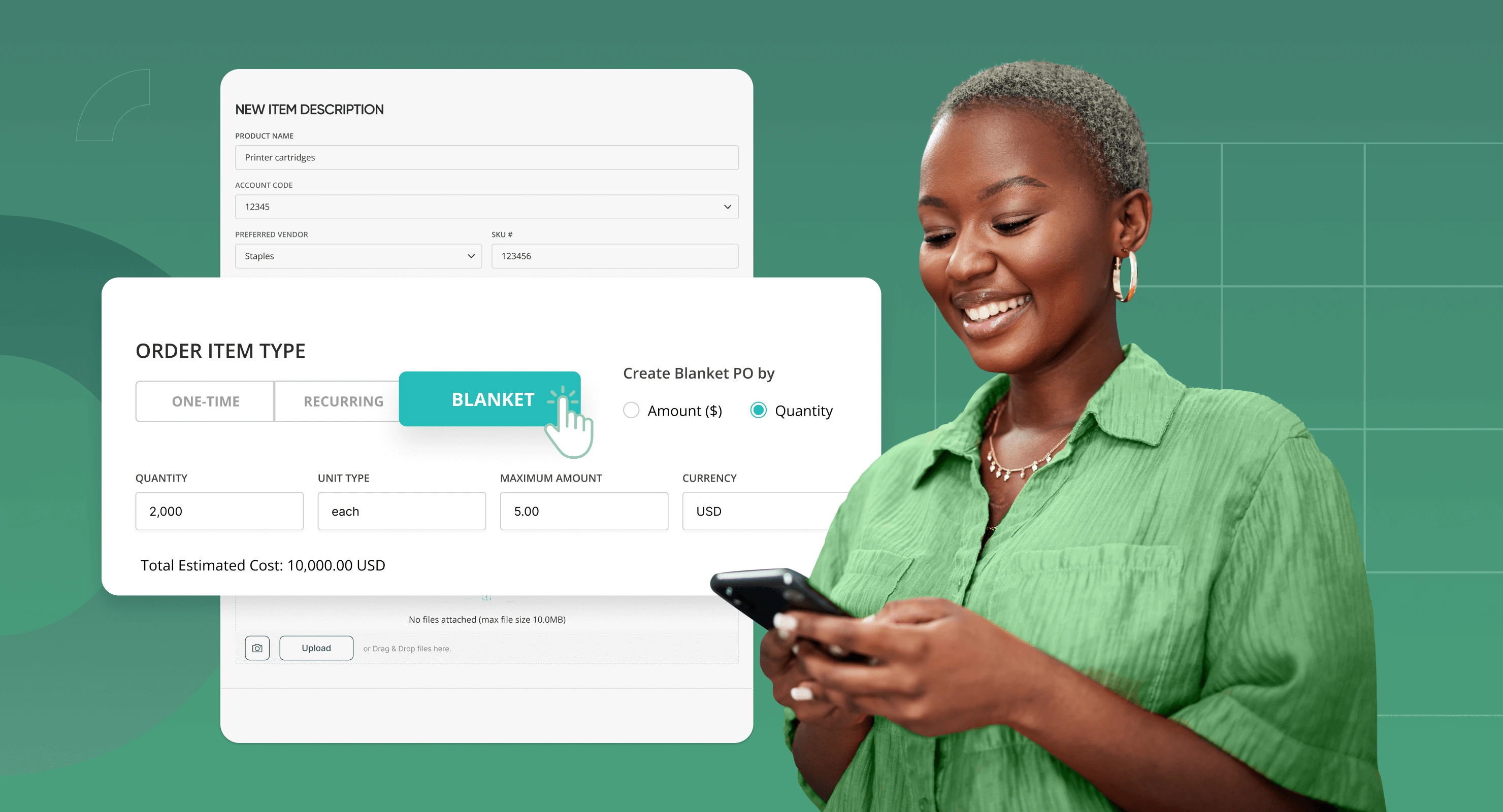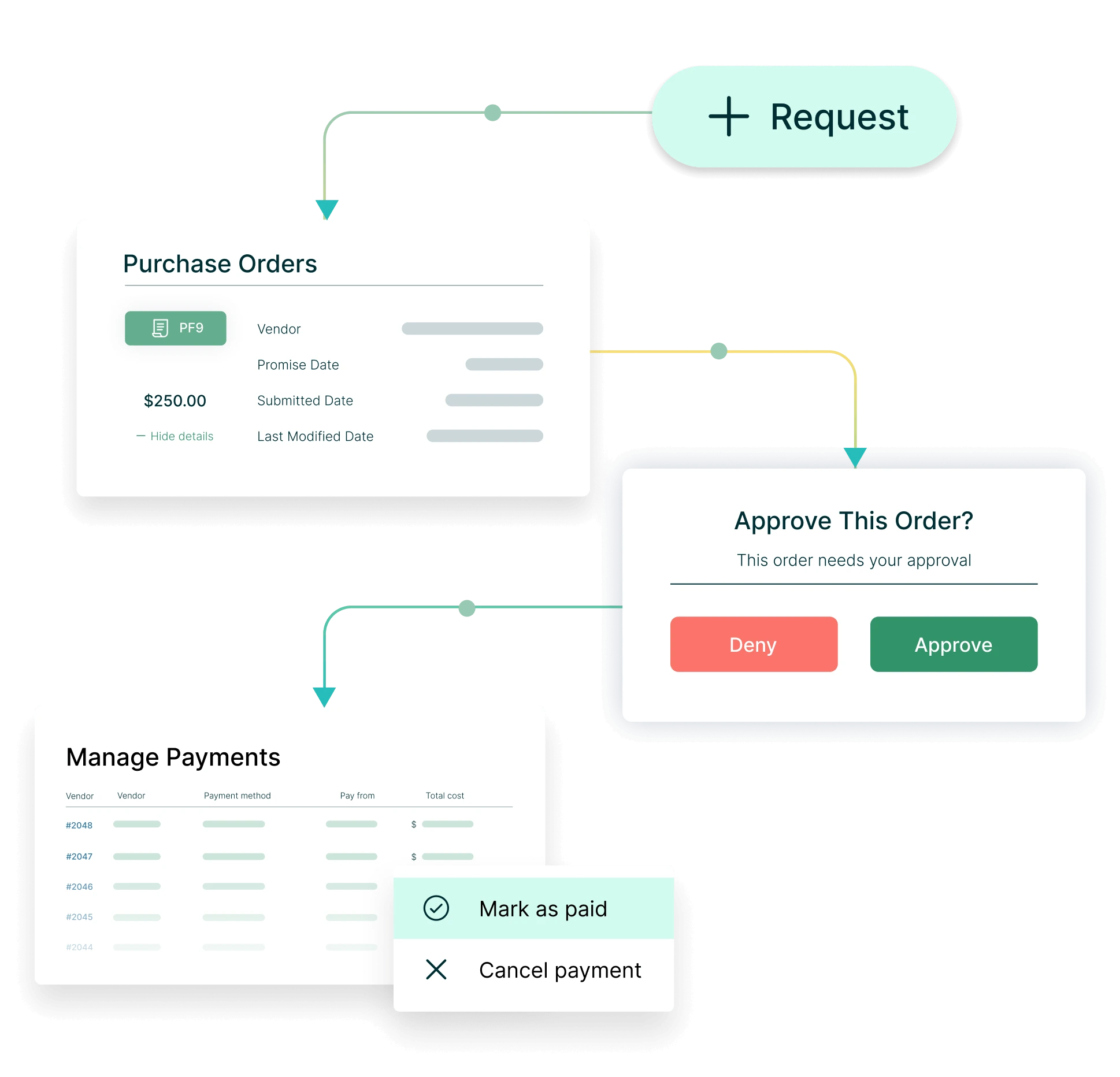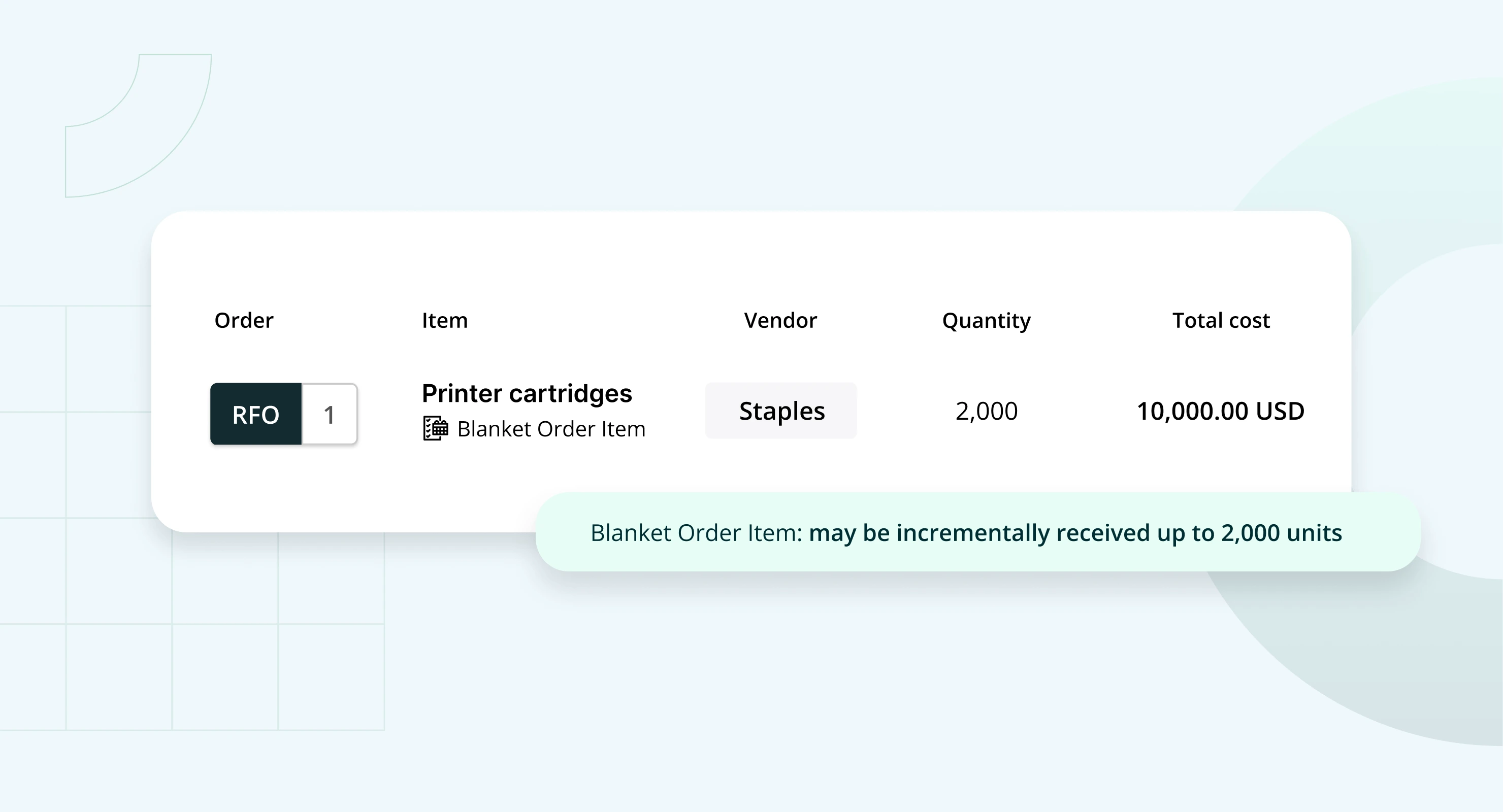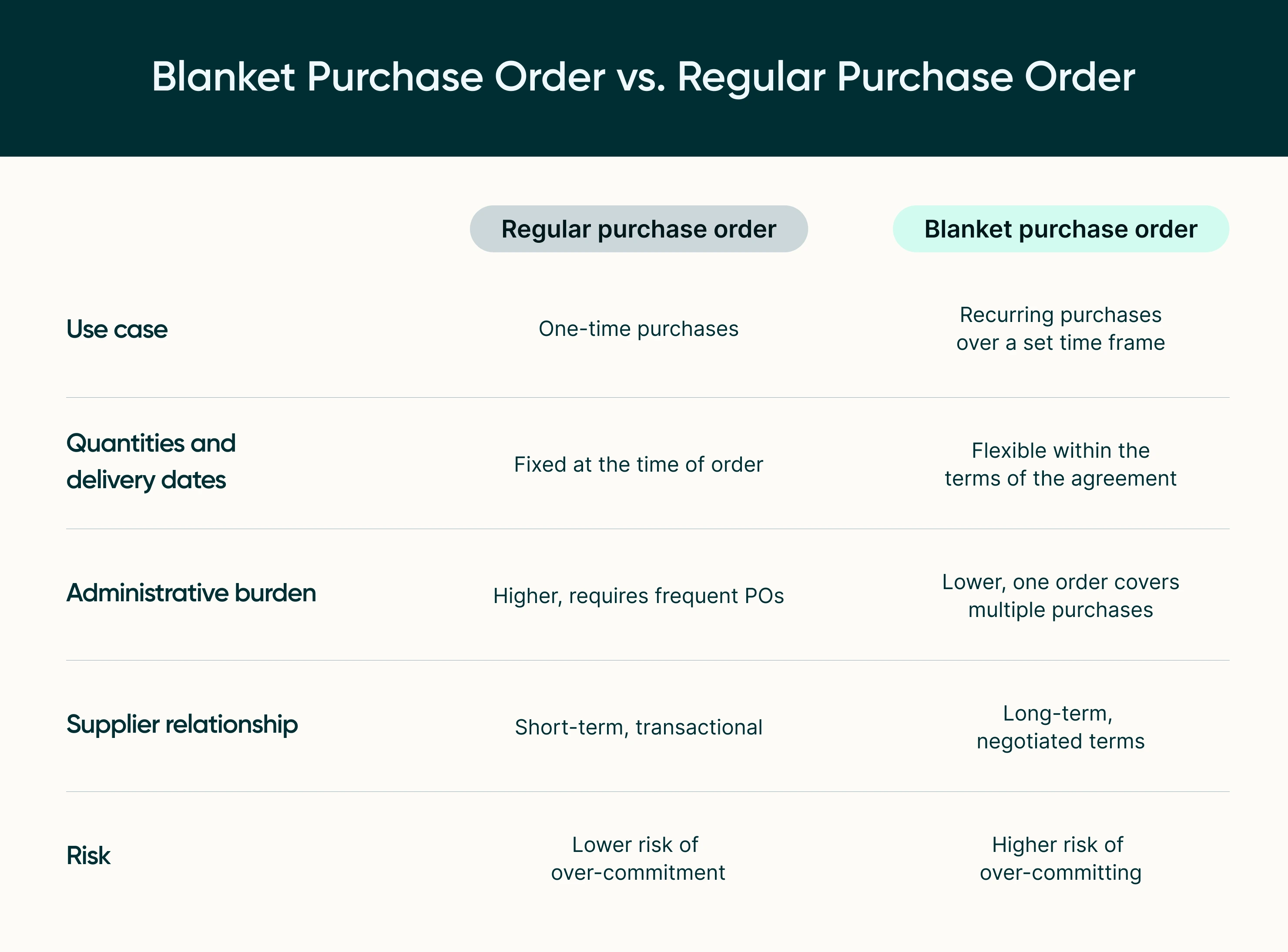
Blanket Purchase Orders 101: Save Time, Cut Costs, and Simplify Recurring Purchases
A blanket purchase order (BPO) is a long-term agreement between a buyer and a supplier that covers recurring purchases over a set period at pre-negotiated terms. Unlike regular purchase orders, which are created for one-time transactions, a BPO consolidates repeat needs into a single streamlined agreement.
By reducing paperwork, locking in pricing, and strengthening supplier relationships, BPOs are especially valuable for mid-sized and large organizations with steady demand — from office supplies to raw materials. These agreements typically include set terms like duration, quantities, and pricing, giving businesses predictability and efficiency in procurement.
For example, a manufacturing company that regularly orders packaging materials from the same supplier might set up a blanket purchase order to cover its estimated annual requirements. This allows them to place orders as needed throughout the year, while still benefiting from pre-negotiated terms such as bulk discounts or consistent pricing.
The key elements of a blanket purchase order typically include:
-
Duration: The time period covered by the agreement, often one year.
-
Quantities: While the total amount of goods or services may be capped, the exact quantities and delivery dates are usually flexible.
-
Pricing: Fixed pricing for the duration of the agreement, which can help businesses with budget planning and forecasting.
-
Cancellation clause: Terms outlining how either party can cancel or adjust the order if necessary.

Streamline Your Purchase Order Process
Procurify’s purchase order software automates your company’s purchasing workflow from order creation all the way to invoice payment – to speed up purchasing, improve internal communication, and minimize financial risk.
What are the benefits of a blanket purchase order?
What are the benefits of a blanket purchase order?
The main advantages of BPOs come down to efficiency, cost savings, stronger supplier partnerships, and better financial control. By consolidating repetitive purchases into a single agreement, companies reduce administrative overhead, improve supplier relationships, and manage budgets more predictably.
Below are the key advantages of using a BPO:
-
Reduced administrative work
One of the biggest advantages of a BPO is the reduction in paperwork and administrative tasks. With a standard purchase order, each transaction requires creating, approving, and processing an individual order. This can become cumbersome when purchasing the same goods or services repeatedly. By using a blanket purchase order, businesses only need to set up the order once for a set period (usually a year), eliminating the need for repetitive paperwork. This not only reduces the workload for the procurement team but also speeds up the entire purchasing process.
-
Cost savings through bulk purchasing
BPOs help companies save money by locking in pricing and reducing the need to renegotiate every order. Because blanket agreements signal long-term commitment, suppliers are often willing to offer volume discounts, stable pricing, or other favorable terms to secure the business.
These savings are especially impactful for organizations that buy in large or predictable quantities. For instance, a manufacturer might use a BPO for raw materials like packaging or steel, while a healthcare provider could use one for recurring medical supplies. In both cases, the buyer gains lower per-unit costs and predictable spend, while the supplier benefits from steady revenue and reliable demand.
In both cases, the buyer gains lower per-unit costs and predictable spend, while the supplier benefits from steady revenue and reliable demand.
Real-world results back this up — in a case study with Mitra Chem, the team streamlined frequent bulk purchases across 100+ SKUs and multiple vendors, improving both cost control and vendor management efficiency.
-
Improved supplier relationships
The long-term nature of a blanket purchase order fosters stronger vendor relationships and better vendor management. A BPO creates stability and predictability for both parties, allowing the supplier to plan production or service delivery with confidence. In return, the buyer benefits from reliable service, often enjoying prioritized delivery and more favorable payment terms. This strong relationship can also lead to further negotiations and customized solutions that may not be available through one-off purchases.
-
Efficient budget management
Blanket Purchase orders make budgeting more predictable. With pricing and quantities set upfront, companies can forecast expenses with greater confidence and avoid the uncertainty of fluctuating prices or unplanned procurement costs. For example, a manufacturer that knows it will need raw materials throughout the year can lock in stable pricing and protect margins even if market rates rise.
This visibility doesn’t just support day-to-day operations — it gives finance leaders reliable data for long-term planning, more accurate forecasts, and procurement strategies that align closely with business goals.
-
Shortened lead times
Blanket purchase ordersspeed up procurement.Since the terms are already agreed upon, teams don’t have to renegotiate or create new orders each time they need supplies. This means faster deliveries and fewer bottlenecks in the purchasing process.
For industries where timing is critical — like healthcare reordering medical supplies or manufacturers replenishing production materials — shorter lead times keep operations running smoothly. It also allows companies to maintain leaner inventories, lowering the risk of costly stockouts or excess stock sitting unused.
What’s the difference between a blanket purchase order and a regular purchase order?
What’s the difference between a blanket purchase order and a regular purchase order?
The key difference is that regular purchase orders are created for single, one-time purchases, while blanket purchase orders are designed for recurring needs over a longer period under pre-negotiated terms.

-
Duration and use cases
The most fundamental difference between a BPO and a regular PO is its duration and intended use.
- A regular purchase order is typically used for one-time purchases. It’s created to fulfill a specific order, and once the transaction is completed (goods delivered and payment made), the PO is closed. Regular POs are ideal when the buyer knows the exact quantity and delivery time of the products required.
- A blanket purchase order, on the other hand, is designed for recurring purchases over a set period, usually a year. BPOs are typically used when the buyer has a continuous need for a product or service from a single supplier, and exact quantities or delivery dates are not immediately known.
-
Flexibility in quantities and deliveries
- With a regular PO, everything is fixed at the time of order. The buyer must specify the exact quantity, delivery date, and terms upfront. This can make regular POs less flexible, particularly for long-term needs.
- A BPO, however, offers much more flexibility. Quantities and delivery dates don’t need to be determined at the outset. The buyer can order as needed within the limits of the BPO agreement, making it a better fit for businesses with fluctuating demand or uncertain schedules. In urgent cases, some organizations also rely on non-PO purchase to move quickly without formal approvals.
-
Administrative burden
- A regular PO creates more administrative work for procurement teams since a new order must be issued each time a purchase is made. This increases the amount of paperwork and slows down the procurement process, particularly when dealing with high-frequency purchases.
- A BPO simplifies this process by reducing the need for multiple purchase orders. Once a BPO is set up, businesses can place multiple orders against it without issuing new POs. This streamlines operations and reduces the administrative burden on procurement teams.
-
Supplier relationship and terms
- A regular PO usually involves less long-term commitment. Once the terms are fulfilled, the relationship with the supplier may or may not continue, depending on future needs. It is transactional and often used for one-off or short-term purchases.
- With a BPO, the buyer and supplier typically enter a long-term relationship. By agreeing to recurring purchases, buyers often negotiate favorable terms, such as better pricing or prioritized deliveries. The extended commitment provides stability for the supplier and cost savings for the buyer which is why BPOs often appear in efficient purchase order management strategies.
-
Risk management
- Regular POs pose less risk for over-committing since each order is created with a defined need in mind. However, they can introduce risks of delays in delivery if there is no prior agreement in place.
- BPOs can introduce a risk of over-committing to a supplier if not carefully managed. There’s also the potential for stockpiling goods or missing out on better deals if market prices change during the BPO period.

In summary, regular purchase orders are best suited for one-off transactions where the specifics are clear, while blanket purchase orders provide a more efficient solution for ongoing procurement needs. Understanding the differences and applying the appropriate type of purchase order helps businesses optimize their procurement strategies and ensure they are managing supplier relationships effectively.
Risks and challenges of blanket purchase orders
While blanket purchase orders (BPOs) provide numerous benefits, there are also potential risks and challenges that organizations must manage effectively. Failure to properly administer a BPO can result in over-commitment, supplier dependency, or even financial risks. Below are some of the most common challenges associated with using a BPO:
-
Risk of over-commitment
ne of the key risks with blanket purchase orders is the potential for over-commitment. Since BPOs are typically set for a long duration and large quantities, businesses might commit to purchasing more goods or services than they need. This can lead to excessive stock, overuse of allocated budgets, or wastage.
Over-committing to a supplier for a long period can also reduce flexibility in responding to market changes or better offers from competitors.
-
Supplier dependency
While building strong relationships with suppliers is often beneficial, a BPO can sometimes create an unhealthy level of supplier dependency. By locking into long-term agreements with a single supplier, companies can become vulnerable if that supplier faces operational issues, financial instability, or fails to deliver on time. This dependency can also limit a company’s ability to switch suppliers if quality declines or if better alternatives become available.
-
Limited flexibility
Blanket purchase orders are designed for predictable, recurring purchases, but they can lack the flexibility needed when demand changes unexpectedly. If a business’s needs fluctuate significantly, it may find itself stuck with orders that no longer align with its actual requirements.
This can lead to either excess stock or shortages, both of which can disrupt operations and negatively impact financial performance.
-
Administrative complexity
While BPOs are intended to reduce administrative workload, managing and monitoring these long-term agreements can still present challenges. Proper oversight is necessary to ensure that spending is kept within the terms of the BPO and that it doesn’t exceed the agreed limits. Without effective tracking and communication systems in place, procurement teams may struggle to manage BPO usage efficiently.
Additionally, year-end reconciliation and closing out BPOs can become time-consuming if not handled properly.
-
Price lock-in risks
One of the advantages of a BPO is securing stable pricing over a long period, but this can also be a disadvantage if market prices drop during the agreement period. Being locked into a fixed price for a year or more can mean missing out on more competitive rates from other suppliers, which could have been secured through renegotiation or bidding processes.
This price lock-in can hinder cost optimization, especially in volatile markets.
-
Quality control issues
Reliance on a single supplier through a BPO may lead to quality control issues over time. Suppliers who feel secure in long-term contracts might become complacent, and quality may deteriorate as a result. Without regular assessments and clear performance metrics, businesses risk accepting subpar goods or services, which can impact the overall performance of the company.
-
Compliance and legal risks
Companies must stay vigilant regarding the compliance and legal risks associated with BPOs. Changes in regulations or contractual obligations can impact the validity of a BPO, especially in industries with stringent compliance requirements. Ensuring that both the company and the supplier adhere to all applicable laws and contractual terms is essential to avoid legal complications.
In summary, while BPOs offer streamlined procurement processes and cost advantages, careful management is crucial to avoid over-commitment, supplier risks, and compliance issues. Implementing best practices and regularly reviewing agreements can mitigate these challenges.
Best practices for managing blanket purchase orders
Effectively managing a purchase order process is critical to leveraging its benefits and avoiding potential pitfalls. Proper oversight ensures that the BPO delivers value, controls spending, and enhances procurement efficiency. Here are some best practices for successfully managing a BPO:

-
Regularly review and track usage
It is essential to continuously monitor the usage of blanket purchase orders throughout the agreement period. A BPO is often set up with a maximum limit on quantities or spending, so keeping track of how much has been ordered against the BPO is vital to ensure that procurement does not exceed this limit.
Utilizing procurement management software can automate this process by providing real-time insights and alerts when the limits are approaching. Regular reviews also ensure that the BPO remains aligned with the company’s current needs and purchasing patterns.
-
Establish clear performance metrics for suppliers
To avoid quality control issues, it’s important to set clear performance benchmarks for suppliers from the outset. These can include key performance indicators (KPIs) such as on-time delivery, product quality, and adherence to agreed pricing and terms.
Regular performance evaluations, combined with open communication, ensure that suppliers remain accountable and that the buyer receives consistent quality and service throughout the BPO period.
-
Implement an approval workflow
An efficient approval process is crucial for managing blanket purchase orders, especially when multiple teams or departments are involved in ordering. A structured workflow ensures that each order placed against a BPO is reviewed and approved by the appropriate personnel before being submitted to the supplier.
This prevents over-ordering, ensures compliance with company policies, and guarantees that the items ordered align with business needs. Procurement software often includes approval workflows that can be customized based on organizational hierarchies and requirements.
-
Set flexibility clauses in contracts
Although BPOs are designed for recurring purchases, business needs can change unexpectedly. To safeguard against over-commitment or shifts in demand, include flexibility clauses in the blanket purchase agreement that allow for adjustments to quantities, prices, or delivery schedules as needed.
These clauses provide room for renegotiation if market prices fluctuate or if the organization’s requirements evolve during the contract period. Ensuring that flexibility is built into the BPO protects the company from unnecessary risks and helps maintain procurement agility.
-
Use technology for automation and reporting
Leverage procurement software to automate the entire BPO process—from issuing orders and tracking deliveries to monitoring spending and receiving supplier invoices. This technology can also generate regular reports that provide visibility into BPO usage, spending trends, and supplier performance.
Automation reduces human error, streamlines administrative tasks, and offers procurement teams more time to focus on strategic activities, such as negotiating better terms or sourcing new suppliers.
-
Conduct year-end reconciliation
At the end of the BPO period (often one year), it is important to conduct a thorough reconciliation. This involves reviewing all outstanding orders, ensuring that deliveries have been made as agreed, and closing out the BPO. It’s also an opportunity to evaluate the overall effectiveness of the BPO and to renegotiate or reissue a new blanket purchase order for the following year.
Conducting an end-of-year review helps to identify areas for improvement and ensures that no outstanding liabilities or obligations remain unaccounted for.
-
Communicate clearly with suppliers
Effective communication with suppliers is key to managing a successful BPO. From the outset, make sure that suppliers understand the terms of the BPO, including the quantities, delivery expectations, and any flexibility clauses.
Throughout the agreement period, maintain regular communication to address any issues, such as delays or quality concerns. Establishing a clear feedback loop fosters a collaborative relationship with the supplier and ensures that both parties remain aligned on expectations.
-
Align BPOs with overall procurement strategy
Finally, ensure that your BPO strategy aligns with the broader goals of your procurement department. Whether the focus is on cost savings, supplier relationships, or operational efficiency, BPOs should complement and support the company’s overall procurement objectives.
Regularly revisit the company’s procurement strategy to confirm that the use of BPOs is driving the desired outcomes and contributing to the organization’s growth.
In summary, managing a blanket purchase order effectively requires a combination of regular monitoring, clear communication with suppliers, and the strategic use of technology. Following these best practices will help your organization maximize the value of BPOs while minimizing risks and ensuring procurement processes remain efficient and aligned with company goals.
Section 6: Frequently Asked Questions
To further clarify the use of blanket purchase orders (BPOs) and help businesses optimize their procurement processes, here are answers to some common questions:
Conclusion
In summary, a Blanket Purchase Order (BPO) is a powerful tool for streamlining procurement, reducing administrative burdens, and fostering long-term relationships with suppliers. By consolidating recurring purchases into one agreement, businesses can negotiate favorable pricing, improve efficiency, and better manage their budgets.
However, it’s important to be aware of the potential risks associated with BPOs, such as over-commitment, supplier dependency, and the need for effective management to avoid pitfalls like over-ordering or exceeding budget limits.
Regular tracking of usage, clear communication with suppliers, and leveraging procurement software for automation help mitigate these risks and ensure that your BPO strategy remains aligned with your overall business goals.
As you consider implementing or optimizing your use of blanket purchase orders, keep in mind the key takeaways:
- Always review the terms and performance
- Set flexibility clauses to adapt to changing needs
- Maintain strong supplier relationships to maximize the value of your procurement efforts
With careful planning and management, BPOs can provide significant operational benefits, making them a valuable asset for companies that rely on recurring purchases.
And when paired with a connected purchase order system, blanket POs become even more powerful — giving finance and procurement teams the visibility, control, and efficiency they need to support sustainable growth.
If you’re evaluating purchase order software, download our buyer’s guide for a complete checklist of what to look for.

2025 Procurement Benchmark Report
Powered by $20B+ in proprietary data you won’t find anywhere else.
